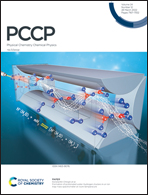Nitrous acid (HONO) as a sink of the simplest Criegee intermediate in the atmosphere†
Abstract
In the present work, we have investigated the reaction of nitrous acid with the simplest Criegee intermediate using chemical kinetics and quantum chemical calculations. It was found that reactions can occur through four different paths. Among them, one path involves hydrogen atom transfer and leads to the formation of hydroperoxymethyl nitrite, while two paths involve cycloaddition leading to the formation of ozonide and formic acid and the remaining path involves oxygen atom transfer leading to the formation of HNO3 as a final product. Although there are various oxidation reactions of HONO present in the literature, which produce nitrogen dioxide as a final product, the possibility of in situ generation of HNO3 and formic acid from HONO is reported for the first time. Nevertheless, the hydrogen atom transfer path, which leads to the formation of hydroperoxymethyl nitrite as a final product, was found to be the fastest, and hence dominating the Criegee reaction with HONO. By comparing the title reaction with other dominant Criegee reactions, it was found that although it will be more effective than Criegee oxidation by Cl˙ or ClO˙ and can compete with Criegee oxidation by OH˙ under special circumstances, it is negligible compared to the reaction of the Criegee intermediate with a water molecule.



 Please wait while we load your content...
Please wait while we load your content...